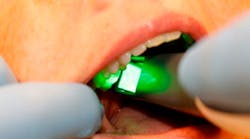How to effectively incorporate intraoral cameras into your practice
They say a picture is worth a thousand words. When it comes to cameras and dentistry, I couldn’t agree more. You made the wise decision to purchase an intraoral camera because you thought it would be a good addition to your practice. The problem is that it’s not being used, and currently there is little or no return on your investment.
There are a few reasons this could be happening, and there are many ways to find a solution. Reasons for no return could be:
1) The team is not on board. They were either not part of the process or did not buy into its value as an educational and diagnostic tool.
2) The technology is not integrated well into the existing software so it does not work well. Everyone is frustrated, and this results in the clinical team avoiding it.
3) There is no strategy for the implementation of the camera as an educational and diagnostic tool.
How do these problems get solved?
If the intraoral camerahas not beenpurchased yet but is being met with resistance:
• Get the team on board. Let them do some of the research by reading articles, blogs, reviews, etc. to build a confidence and develop ownership in the purchasing decision.
• When representatives from the different companies come into the office for a demonstration, insist that the camera you’re considering be left with you for 24 to 48 hours. The trained representative makes working it look easy and teams who make a decision after a one- to two-hour demo find themselves frustrated when it arrives and the excitement dissipates. Having the camera in the office for a day or two gives team members a chance to familiarize themselves with the technology and see how well it integrates with the office software.
• Make a list of challenges and questions that don’t come up in the initial demo and present them to the representative when he or she returns. This way all concerns are addressed up front, leaving more room for embracing the new tool and incorporating it successfully into the practice.
If the camera has already beenpurchased and is not being utilized to its full capacity, find out what is holding everyone back:
• If it is a software issue, make sure you have good technology support from experienced professionals. Stay on it until the issues are resolved.
• Schedule time – actually block it out –- for training. Have clinical team members practice on each other and get the business team involved as well. Amazing discussions and findings occur during these sessions.
• Most importantly, develop a strategy on implementation of the images. Use correct verbiage to determine the when, where, who, what, why and how images will be taken. Turning your technology into an effective system in your practice takes practice, organization, and communication among all team members, and the time is very worth it! Results speak for themselves. When your technology becomes a system and is a consistent part of the patient experience, your team, your patients, and you will benefit tenfold.
Not only can you use your intraoral camera to diagnose and support necessary treatment, it can also build rapport and strengthen opportunity for future esthetic care with your patients. Use your intraoral camera proactively in the following ways:
• Offset buyer’s remorse by showing patients a recently restored tooth compared to a tooth in their mouth that needs similar treatment.
• Show an image of the smile and ask patients what their thoughts are. If a patient is happy with his or her smile, great! This is your chance to explain the benefits of the current interval of care to maintain it. If someone is not happy, find out why, their wants, and what they would change about their smile if they could.
• The business team can use these images during case presentation as well. Sending patients home with an image of a diagnosed condition attached to a treatment plan is beneficial when they are not the decision maker.
As you can see, the implementation takes time, strategy and effort. Preplanning and developing protocol will help you achieve results and improve treatment acceptance by 25%. The camera will pay for itself. Take the time to maximize it, do what it takes to get everyone on the team on board, and you will see this technology pay for itself over and over again.

